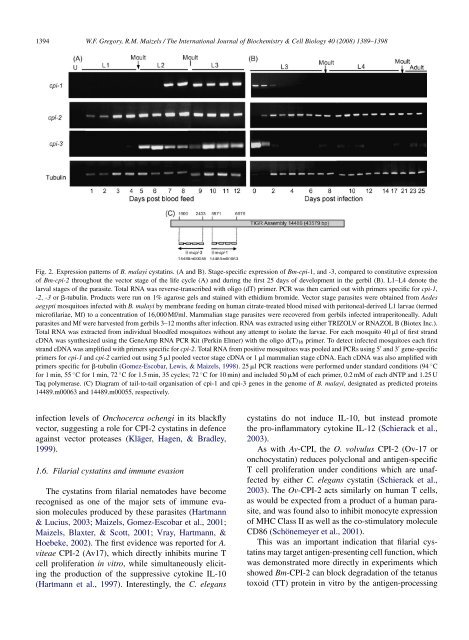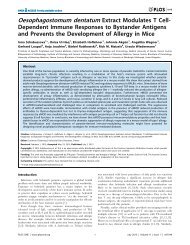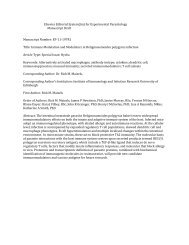Cystatins from filarial parasites - Rick Maizels' Group - University of ...
Cystatins from filarial parasites - Rick Maizels' Group - University of ...
Cystatins from filarial parasites - Rick Maizels' Group - University of ...
You also want an ePaper? Increase the reach of your titles
YUMPU automatically turns print PDFs into web optimized ePapers that Google loves.
1394 W.F. Gregory, R.M. Maizels / The International Journal <strong>of</strong> Biochemistry & Cell Biology 40 (2008) 1389–1398<br />
Fig. 2. Expression patterns <strong>of</strong> B. malayi cystatins. (A and B). Stage-specific expression <strong>of</strong> Bm-cpi-1, and -3, compared to constitutive expression<br />
<strong>of</strong> Bm-cpi-2 throughout the vector stage <strong>of</strong> the life cycle (A) and during the first 25 days <strong>of</strong> development in the gerbil (B). L1–L4 denote the<br />
larval stages <strong>of</strong> the parasite. Total RNA was reverse-transcribed with oligo (dT) primer. PCR was then carried out with primers specific for cpi-1,<br />
-2, -3 or -tubulin. Products were run on 1% agarose gels and stained with ethidium bromide. Vector stage <strong>parasites</strong> were obtained <strong>from</strong> Aedes<br />
aegypti mosquitoes infected with B. malayi by membrane feeding on human citrate-treated blood mixed with peritoneal-derived L1 larvae (termed<br />
micr<strong>of</strong>ilariae, Mf) to a concentration <strong>of</strong> 16,000 Mf/ml. Mammalian stage <strong>parasites</strong> were recovered <strong>from</strong> gerbils infected intraperitoneally. Adult<br />
<strong>parasites</strong> and Mf were harvested <strong>from</strong> gerbils 3–12 months after infection. RNA was extracted using either TRIZOLV or RNAZOL B (Biotex Inc.).<br />
Total RNA was extracted <strong>from</strong> individual bloodfed mosquitoes without any attempt to isolate the larvae. For each mosquito 40 l <strong>of</strong> first strand<br />
cDNA was synthesized using the GeneAmp RNA PCR Kit (Perkin Elmer) with the oligo d(T)16 primer. To detect infected mosquitoes each first<br />
strand cDNA was amplified with primers specific for cpi-2. Total RNA <strong>from</strong> positive mosquitoes was pooled and PCRs using 5 ′ and 3 ′ gene-specific<br />
primers for cpi-1 and cpi-2 carried out using 5 l pooled vector stage cDNA or 1 l mammalian stage cDNA. Each cDNA was also amplified with<br />
primers specific for -tubulin (Gomez-Escobar, Lewis, & Maizels, 1998). 25 l PCR reactions were performed under standard conditions (94 ◦ C<br />
for 1 min, 55 ◦ C for 1 min, 72 ◦ C for 1.5 min, 35 cycles; 72 ◦ C for 10 min) and included 50 M <strong>of</strong> each primer, 0.2 mM <strong>of</strong> each dNTP and 1.25 U<br />
Taq polymerase. (C) Diagram <strong>of</strong> tail-to-tail organisation <strong>of</strong> cpi-1 and cpi-3 genes in the genome <strong>of</strong> B. malayi, designated as predicted proteins<br />
14489.m00063 and 14489.m00055, respectively.<br />
infection levels <strong>of</strong> Onchocerca ochengi in its blackfly<br />
vector, suggesting a role for CPI-2 cystatins in defence<br />
against vector proteases (Kläger, Hagen, & Bradley,<br />
1999).<br />
1.6. Filarial cystatins and immune evasion<br />
The cystatins <strong>from</strong> <strong>filarial</strong> nematodes have become<br />
recognised as one <strong>of</strong> the major sets <strong>of</strong> immune evasion<br />
molecules produced by these <strong>parasites</strong> (Hartmann<br />
& Lucius, 2003; Maizels, Gomez-Escobar et al., 2001;<br />
Maizels, Blaxter, & Scott, 2001; Vray, Hartmann, &<br />
Hoebeke, 2002). The first evidence was reported for A.<br />
viteae CPI-2 (Av17), which directly inhibits murine T<br />
cell proliferation in vitro, while simultaneously eliciting<br />
the production <strong>of</strong> the suppressive cytokine IL-10<br />
(Hartmann et al., 1997). Interestingly, the C. elegans<br />
cystatins do not induce IL-10, but instead promote<br />
the pro-inflammatory cytokine IL-12 (Schierack et al.,<br />
2003).<br />
As with Av-CPI, the O. volvulus CPI-2 (Ov-17 or<br />
onchocystatin) reduces polyclonal and antigen-specific<br />
T cell proliferation under conditions which are unaffected<br />
by either C. elegans cystatin (Schierack et al.,<br />
2003). The Ov-CPI-2 acts similarly on human T cells,<br />
as would be expected <strong>from</strong> a product <strong>of</strong> a human parasite,<br />
and was found also to inhibit monocyte expression<br />
<strong>of</strong> MHC Class II as well as the co-stimulatory molecule<br />
CD86 (Schönemeyer et al., 2001).<br />
This was an important indication that <strong>filarial</strong> cystatins<br />
may target antigen-presenting cell function, which<br />
was demonstrated more directly in experiments which<br />
showed Bm-CPI-2 can block degradation <strong>of</strong> the tetanus<br />
toxoid (TT) protein in vitro by the antigen-processing





